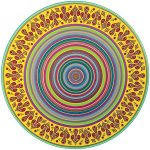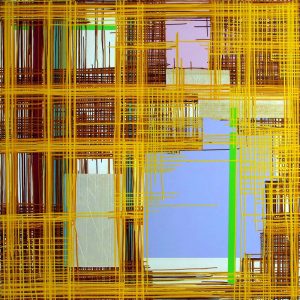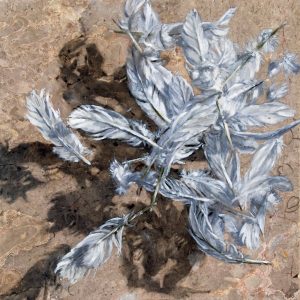Brief Picture: Exhibitions at R.B. Stevenson, Scott White, & Quint Galleries
June gloom is finally here, but local art galleries just might be the place to hang out if you want to avoid this month’s dreaded San Diego “weather” with its penchant for blistering cloud burn.

Ricardo Xavier;
“Once Everything was Adjusted,” 2012.
Mixed media on canvas on wood panel; 46 Ø in. Photo credit: Erubiel Acevedo. Image courtesy of R.B. Stevenson Gallery.
Three new painting exhibitions in La Jolla are within easy walking distance from a single parking spot on Girard Avenue. R.B. Stevenson Gallery features a group show, Scott White Contemporary Art has a solo-show by local artist Gail Roberts, and Quint Contemporary Art gallery features another solo-show by LA-based artist Mara De Luca.
“Alternative Approaches,” the group show at R.B. Stevenson Gallery, features artworks by Tim Craighead, Frances McCormack, Molly McCracken, Maggie Tennesen, and Ricardo Xavier—who is a newcomer to the San Diego art scene from Brazil. Xavier works from the joyous, decorative Los Angeles tradition of painting that traces its roots to 1970s CalArts “brats” Roy Dowell, Jim Isermann, and Lari Pittman who were influenced by LA’s decorative design history and refused to succumb to the idea that painting was dead. Xavier’s craft is exacting and he creates multiple layers of colorful patterns that he applies using small silk-screens by meticulously overlaying and registering each small screen again and again on his canvases for each squeegee pull. Three of his canvases are on view. His Unthinkable Ways (2013), is a kaleidoscope of colorful shapes that also manages to create great space, which tends to be absent in works from most of the Los Angeles decorative school of painters. His other two paintings are equally colorful and upbeat.

Maggie Tennesen; “City,” 2006.
Acrylic on canvas; 60 x 60 in. Photo credit: Erubiel Acevedo. Image courtesy of R.B. Stevenson Gallery.
Maggie Tennesen creates paintings featuring wefts and warps of either long drips or narrow stripes of color. In City (2006), Tennesen created a canvas with a pleasant sensation of viewing a city skyscraper being woven together with yarn instead of being constructed from steel. Its slightly off-kilter, yellow to red-violet grid of long, even drips create a complex foreground that jumps in front of great views of tinted background areas of blue, turquoise, and violet. Her other, more recent canvases feature fiestas of pinstripes in multiple hues that optically mix to form geometric abstract shapes. Tennessen achieves an essence not of Hans Hofmann’s “push and pull” but more of her own “torque and twist” where rigid rectangles appear to bend in space. Not being “funereal,” Tennesen’s pinstripe paintings are warm and inviting and allow a viewer to get more than “what you see is what you see.”
Bay Area painter Molly McCracken offers new paintings with layers of different hues that have been sanded down to create sensuous tone on tone backgrounds where henna mehndi inspired designs float on the surface. Tim Craighead offers a large untitled easel painting that when viewed from very near makes one want to be engulfed by its atmospheric qualities. Craighead usually paints much larger canvases where a viewer can stand before them and feel as though he or she is inside the painting. Unfortunately, this smaller-scale canvas doesn’t translate this sensation as well as in his larger-scale canvases.
“Gail Roberts: Spiral,” on view at Scott White Contemporary Art, features colorful paintings with subjects of bird’s nests and feathers. In her painting Litter (2013), a tornado of twigs is seated in awkward position just above the very center of the canvas. As painted with Roberts’s fine gift for color and brushwork, the canvas’s nest plays on the theme of the spiral: how twigs intertwine into a nest’s naturally reoccurring circular form based on repeating Golden Rectangles, known as the Golden Spiral (aka the Fibonacci Spiral). The many nest paintings in the exhibition impart a disquieting air because of the slight, intentional imbalance in each of the compositions. The nests are also all empty save for trace debris of feathers. All of this invokes the notion of the spiral as a symbol for decay, entropy, and loss.

Gail Roberts; “Blanket: Twenty-one Seagull” (2013) from Roberts’s “Fibonacci Series.” Image: © 2013 by Gail Roberts. Image courtesy of Scott White Contemporary Art.
Less disquieting is Robert’s “Fibonacci Series.” This grid of twelve paintings on marble tiles each depicts certain amounts of feathers that follow the mathematical formula for the Fibonacci numerical sequence: 1, 2, 3, 5, 8, 31, 21, etc. The amount of depicted feathers in each of the paintings is the sum of the feathers from the previous two works in the series. The twelve paintings in the cycle begin with Blanket: One Hawk (2013). Here, Roberts painted one isolated feather appearing to float above the background of the marble square along with the feather’s cast shadow that appears to be on the tile itself. A few extra painted trompe l’oeil veins of color have also been added to the marble tile. This artwork and most of the others in the series assume a sensual tranquility that complements the calculated mathematical sequence.
As the series progresses, the logic of the required number of feathers remains faithful and necessary to the concept, although the additional painted cast shadows slowly become burdensome due to the compositions becoming overly busy. This is particularly true in the final two panels of the twelve-part series, Blanket: One Hundred Forty-four Pheasant (2013) and Blanket: Two Hundred Thirty-three Turkey (2013), which become visual cataclysms. Especially the eleventh panel that features tiny pheasant feathers, it completely loses coherence and tranquil unity to become a mere triumph in painting one hundred forty-four small quills. Though, this is the finest overall exhibition of Robert’s work in recent memory.
“Mara De Luca: Even if the Lights Go Out” at Quint Contempory Art features mixed media paintings by an actual CalArts “brat” who graduated from the famed art school in 2004. Mara De Luca presents many large-scale works inspired by turn-of the-twentieth-century existential poet Rainer Maria Rilke’s “Duino Elegies.” With their large size and the concept of “elegy” being an inspiration, one might think of Robert Motherwell’s famous “Elegy to the Spanish Republic” series. However, De Luca’s series looks more like odes to Helen Frankenthaler’s poured paintings and an attempt at capturing Barnet Newman’s concept of the sublime. De Luca uses vast tonal expanses of low key chromatic grays and shades of red that summon a somber disposition. Though, for large scale works they are surprising at being such enjoyably intimate experiences.
Her mixed media works include substantial dyed swaths of a thin polyester fabric, akin to women’s stockings, which are applied to the canvases’ surfaces. In many compositions, large areas of the polyester have been selectively torn off, which give the canvases their Frankenthaler-like poured feeling. Close inspection of each tear’s remaining edges, with their slight lift from the surface, give these overall somber paintings an exciting visually tactile quality. From afar, De Luca’s Elegy VIII.IV (SV) (2013) is a quiet atmospheric work, but, from up-close, the torn fabric at the top of the canvas imparts a smoldering vitality. Other works that do not feature such tearing such as De Luca’s Elegy X.IV (SV) (2013), with its continuums of subtle dark red shades, just communicate ethereal gloom rather than Newman’s sublimity. The artworks without the torn polyester fall short due to the Promethean burden of their overwrought moodiness.
These three exhibitions might be the delightful antidote of colorful and engaging bloom that one usually can’t find in the region’s annual month of gloom.
“Alternative Approaches” runs June 8 through July 20th, “Gail Roberts: Spiral” runs June 8th through July 27th, and “Mara De Luca: Even if the Lights Go Out” runs June 8th through July 27th.
© 2013 by Kraig Cavanaugh

Kraig Cavanaugh lectures about art history—specializing in Modern & Contemporary Art—as well as being an instructor of color theory, design, and studio art. He has curated numerous art exhibitions, authored exhibition catalogues, and written art reviews for several other print and online journals including “Artweek” (USA) and “Selvedge” (UK) magazines. Cavanaugh is also an invited member of the Association Internationale des Critiques d’Art (United States division), which is an NGO in official relations with UNESCO.

I found this article informative re: SD art. Thanks.